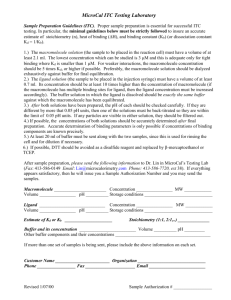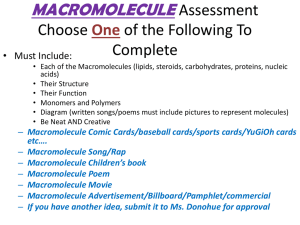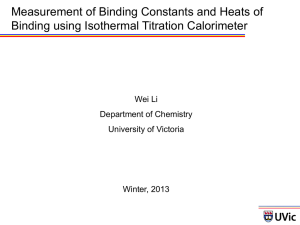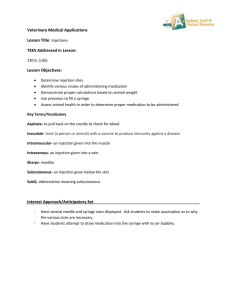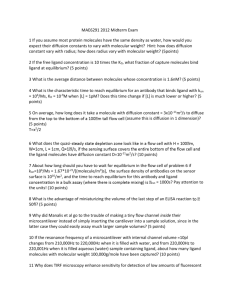Manual
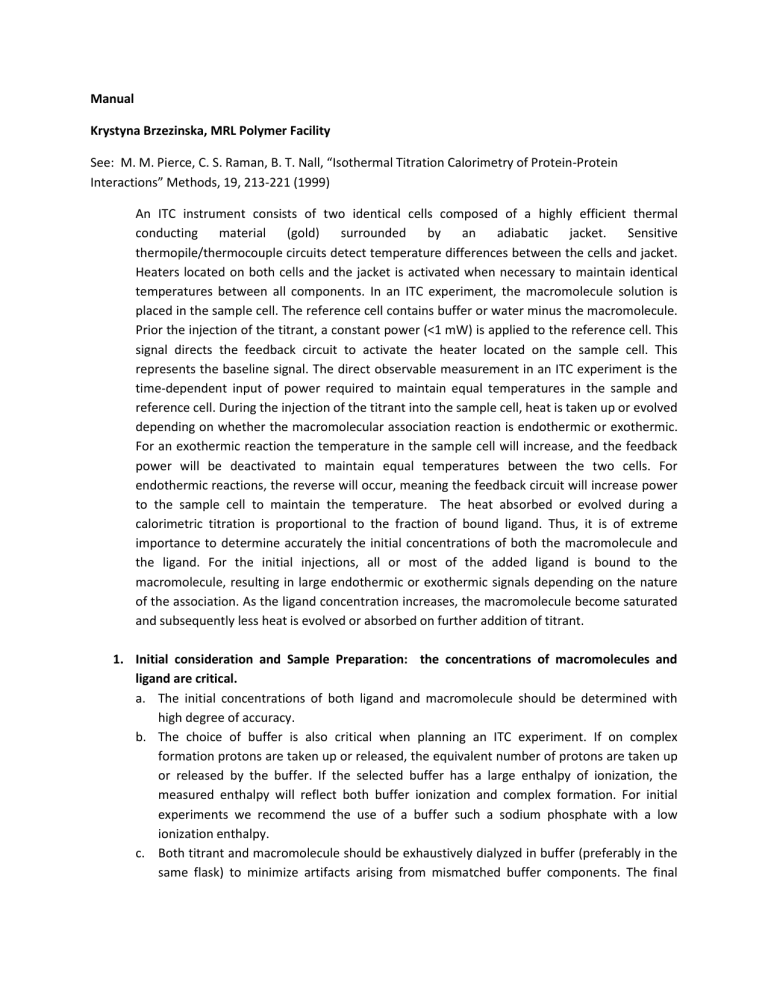
Manual
Krystyna Brzezinska, MRL Polymer Facility
See: M. M. Pierce, C. S. Raman, B. T. Nall, “Isothermal Titration Calorimetry of Protein-Protein
Interactions” Methods, 19, 213-221 (1999)
An ITC instrument consists of two identical cells composed of a highly efficient thermal conducting material (gold) surrounded by an adiabatic jacket. Sensitive thermopile/thermocouple circuits detect temperature differences between the cells and jacket.
Heaters located on both cells and the jacket is activated when necessary to maintain identical temperatures between all components. In an ITC experiment, the macromolecule solution is placed in the sample cell. The reference cell contains buffer or water minus the macromolecule.
Prior the injection of the titrant, a constant power (<1 mW) is applied to the reference cell. This signal directs the feedback circuit to activate the heater located on the sample cell. This represents the baseline signal. The direct observable measurement in an ITC experiment is the time-dependent input of power required to maintain equal temperatures in the sample and reference cell. During the injection of the titrant into the sample cell, heat is taken up or evolved depending on whether the macromolecular association reaction is endothermic or exothermic.
For an exothermic reaction the temperature in the sample cell will increase, and the feedback power will be deactivated to maintain equal temperatures between the two cells. For endothermic reactions, the reverse will occur, meaning the feedback circuit will increase power to the sample cell to maintain the temperature. The heat absorbed or evolved during a calorimetric titration is proportional to the fraction of bound ligand. Thus, it is of extreme importance to determine accurately the initial concentrations of both the macromolecule and the ligand. For the initial injections, all or most of the added ligand is bound to the macromolecule, resulting in large endothermic or exothermic signals depending on the nature of the association. As the ligand concentration increases, the macromolecule become saturated and subsequently less heat is evolved or absorbed on further addition of titrant.
1.
Initial consideration and Sample Preparation: the concentrations of macromolecules and ligand are critical. a.
The initial concentrations of both ligand and macromolecule should be determined with high degree of accuracy. b.
The choice of buffer is also critical when planning an ITC experiment. If on complex formation protons are taken up or released, the equivalent number of protons are taken up or released by the buffer. If the selected buffer has a large enthalpy of ionization, the measured enthalpy will reflect both buffer ionization and complex formation. For initial experiments we recommend the use of a buffer such a sodium phosphate with a low ionization enthalpy. c.
Both titrant and macromolecule should be exhaustively dialyzed in buffer (preferably in the same flask) to minimize artifacts arising from mismatched buffer components. The final
dialysis buffer should be saved and used for any necessary concentration adjustments of the macromolecule or titrant solutions. d.
Macromolecule and ligand are filtered or centrifuged to remove any precipitated material. e.
Immediately prior to loading the sample cell and injection syringe, the ligand and macromolecule solution are degassed to remove residual air bubbles. EVEN THE SMALLEST
AIR BUBBLES REMAINING IN THE CELL OR INJECTION SYRINGE CAN INTERFERE WITH THE
FEEDBACK CIRCUIT. Air bubbles can additionally lead to poor baselines.
2.
Loading the Sample and Reference Cells. a.
The reference cell usually contains water or buffer with 0.01% sodium azide and need not to be changed after every experiment. Solution should be changed on a weekly basis if the instrument is routinely used. b.
The macromolecule is added to the sample cell of the calorimeter using a long needle glass syringe. Typically 1.5 to 2.0 ml of the solution is prepared to fill a cell with a volume of 1.3-
1.5 ml. The utmost care is required to fill the sample cell without introducing air bubbles.
Once the cell is completely filled, several rapid additives of solution will dislodge any residual bubbles that cling to the side of the cell. Any excess solution remaining in the reservoir is removed.
3.
Filling an Attachment of the Injection Syringe.
Filling the injection syringe with titrant or ligand solution also requires great care.
Concentration of ligand solution should be such that the molar ratio of ligand, is approximately 2. Typically, a complete titration will involve approximately fifteen to twenty
5- to 10-µl injections of ligand. Handling of the injection syringe is extremely critical. Great care must be taken to avoid bending of the needle while the injection syringe is loaded into place. Bending of the injection syringe needle can result in some of the titrant solution being expelled into the macromolecule solution, causing the first injection to be unusable. Any minor bending in the syringe can also result in poor baselines when the injection apparatus is stirring.
4.
Experimental Parameters. a.
The parameters of the titration are input into the software program controlling data acquisition. The number, volume, and length of time of injections are critical and are discussed below. To determine accurately the enthalpy of binding, it is critical that the first several shots define a baseline region where all added ligand is bound to macromolecule.
The equivalence region should also be well defined by the concentration range spanned by the injections, to determine an accurate value of the association constant. It is necessary that concentrations be chosen so that measurable amounts of free and bound ligand are in equilibrium within titration zone defined by the titrant injections. b.
For characteristically tight binding affinities such as those exhibited by antibody-antigen complexes this can be impossible task. In the tight binding limit, even when binding constant cannot be determined, it is still possible to determine an accurate value for the binding enthalpy. c.
Several injections should be performed after complete saturation of the macromolecule by ligand. The heat evolved or absorbed following saturation represents the heat of dilution of
the titrant. The length of time of injection should be such that proper mixing is achieved.
Typically TA recommend, 7- to 10 s injections of a ligand. To ensure proper mixing the injection syringe is fitted with a Teflon paddle and attached to a stirring motor by a rubber belt. Stirring at approximately 250 rpm should ensure good mixing.
5.
Control Experiments to Determine Heats of Dilution
The observed heats of binding include contributions from the dilution of the titrant (ligand) and dilution of the macromolecule. A small contribution arising from stirring is also included in the observed binding enthalpy. Several control experiments must be performed to correct for the heats of dilution. The heat of dilution of the ligand is usually the most significant. The heat of dilution of the ligand can be performing an identical titration experiment in which ligand is injected into a sample cell containing buffer only (no macromolecule). The heat of dilution of the macromolecule (which is less significant) is determined by titrating buffer solution into the sample cell containing the macromolecule. The two heats of dilution are used to correct the concentration-normalized binding isotherm.
6.
Data Analysis
The method of data analysis depends on the system of interest. Prior to peak integration, the heats of binding are normalized as a function of ligand concentration. Additionally, a volume correction is also performed due to dilution of the macromolecule during each injection. The areas under the peaks are integrated in a manual peak-by-peak fashion.
Baseline selection is an important factor in ITC data analysis. The n, K a
and ΔH b
parameters are optimized using the procedure for fitting data.
7.
Troubleshooting a.
The enthalpy of binding measurement for the initial injection is less than the subsequent injections (ligand solution slowly leaking) b.
Low binding enthalpies measured after the initial injection can be observed if the injection syringe and drive piston are not exactly aligned (an automatic alignment). c.
Baseline stability (bent injection syringe, air bubbles- degassing solutions longer 5-10 min or taking care in loading the sample cell, condensation around the adiabatic jacket- important for lower temperatures, purge the jacket with dry nitrogen.
